
One of the most important social occasions in Libya is the daily session of tea drinking. Brings families together, to chat, laugh, discuss and gossip about the highlights of the day and about life in general. Talking in Libya is very important social activity; it firmly bonds the family. Libyan tea is rather very strong, thick, syrup-like black tea. After boiling water in a traditional tea pot, one adds a handful of red tea leaves, and leaves to boil for a long time (ten to twenty minutes). Remove the pot from the fire, open the lid, add some sugar, and boil again for a few more minutes. The ready tea is then removed from the fire, left to settle for a few seconds, and served in small glasses (as shown in the photo). Normally this is prepared during a chat session, around which members of the family gather together to socialise for an hour or so before they each carry on with their own separate paths, and during which one drinks two rounds of tea (each round prepared as above and lasts about half an hour). The third round is served with roasted peanuts or roasted almonds (mixed with the tea in the same glass). In special occasions and for those who still follow the old tradition, the tea is first poured into another mug, and then using two mugs, one continuously empties the content of one mug into the other and then back into the original mug for at least twenty or thirty times, to produce what the Libyans call reghwet or reghwa, which can be translated as froth or foam, which is steadily added to one glass at a time as being made. (To see a video of a woman making tea froth, please visit our video gallery and click on the Ghadames video, and forward the video to about the end of the first third of the video.) After all the empty glasses are half-full with froth, the hot tea is poured over the froth and served hot. The trick to produce the froth is to lift one mug as high as possible, by stretching your arm over your head, while pouring the content into the other mug, and then repeat the process by lowering the raised hand and rising the other one, and so on until enough froth has been produced. After meals, the Libyans traditionally always use green tea to aid digestion, and also help eliminate stomach problems after a heavy meal. It really does work. Green tea is better for you, especially when drank without milk. Adding milk destroys much of the powerful effects of its antioxidants. One of the main components of tea are antioxidants. The process of oxidation in the human body causes damage to our cells. A free radical is a charged atom that steals an electron from a healthy cell in order to re-establish its own stability, leaving you with a bit of damaged DNA. Given time, the damage accumulates and as a result one ages faster or even dies quicker. Now comes the important role of antioxidants. They talk to the free radicals, and say: hi, I have some free electrons, do you want some? The free radicals, being lazy radicals, care less where the electrons come from, and thus happily take up the free offer and spare your helpless healthy cells the loss of much-needed electrons. The process of oxidation is accelerated by pollution, alcohol and smoking, and therefore regular supply of green (or red) black tea and vitamins help keep the supply of antioxidants. Ask your Libyan guide to prepare some Libyan tea for you and taste the difference. The above photo is of a tea session we prepared for an Italian group while camping in the desert - in Adiri.
Zummeeta |
Z'ummeeta or zumita is yet another ancient Libyan dish. It is a doughy dish made of mixing water with flour until it is firm and doughy. It is eaten by dipping a small bit, taken by hand, in olive oil, and with the option of dipping in chili sauce. It is usually eaten for breakfast, but some times it is eaten whenever one is hungry, as it takes only few minutes to mix. The flour mix is made of whole grain barley or wheat, a bit of coriander and cumin seeds. These are dry roasted in an empty frying pan until golden brown, then ground into powder, sieved and finally placed in clay jars and put away. Normally this process is done once a year, although the mixture can last for even two years. Whenever you need some z'ummeeta, just take some flour, add a pinch of salt, mix thoroughly with a bit of water, spread on a plate, and pour the olive oil on top. The mixture breaks up in the hand nice and dry, and smells fresh with a hint of coriander and olive oil. The modern way of making it is to mix the oil with the mixture and serve it ready mixed, as in the above photo, normally with a bit of harisa in the middle as a dip.
 |
Couscous (Kesksoo) |
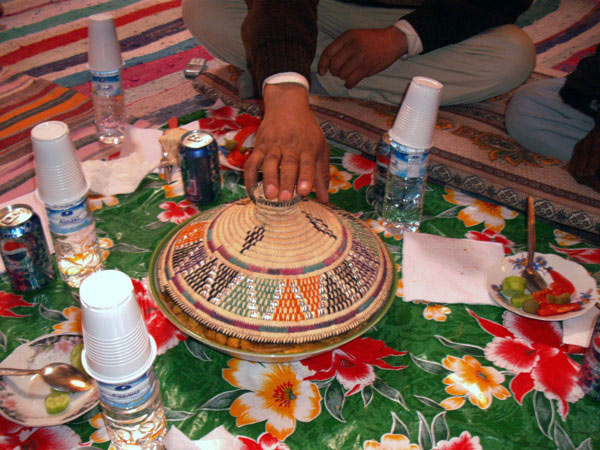 Traditional couscous meal, covered with a straw-made cover.
Traditional couscous meal, covered with a straw-made cover.
I can see the chickpeas (chick peas): an essential ingredient. From Ghadames, Libya.
Couscous is one of the most widely popular dishes in Libya and, for that matter, in the whole of North Africa. Its recent spread in Europe is a testimony to its unique qualities and special taste, rarely found in other dishes. The dish involves cooking two things: the couscous, made of wheat or barley, ground into coarse flour just like semolina (but without the stickiness), and the vegetable and meat sauce to go with it. The couscous: to start with, sprinkle some salt, pepper, olive oil and a bit of water over the couscous grains, then mix thoroughly by hand, from right to left, slowly rolling the couscous grains into larger balls. Keep mixing and adding a few drops of water at a time until the balls become round and about a third the size of a rice grain. Keep mixing in this manner until all couscous has been used. (Nowadays you buy it mixed and ready to steam.) Place the mixture in a special saucepan called "keskas", which is like a steamer or a saucepan with lots of holes, and cover with the lid. This steamer is then placed on top of the other saucepan containing the vegetable and meat sauce, so that the couscous will be cooked by the steam rising from the simmering sauce, thus transferring the flavour to the couscous itself. The modern, commercial way of cooking couscous by placing the contents of the ready-mixed couscous bag in a saucepan and covering it for a few minutes with boiling water does not produce a good quality couscous, but some tasteless stuff you buy in supermarkets. Real couscous needs to be steamed over a good sauce for the flavour to soak in, and then needs to be thoroughly mixed with a bit of extra virgin olive oil to further enhance the flavour, before covering the couscous with the lamb and vegetable sauce. 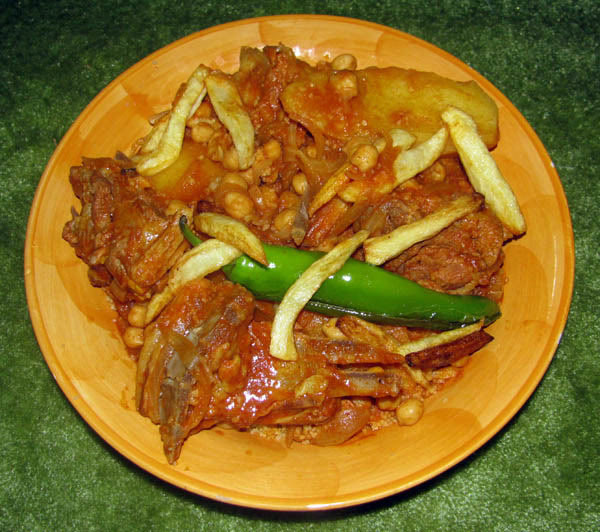
Couscous with meat, vegetables, chickpeas, chips, and A fried hot green pepper on top.
The sauce's recipe: - olive oil, water
- onion & garlic
- spices: chili powder, turmeric, cumin, coriander, salt.
- tomato pure
- vegetable: potatoes, carrots, pumpkin, chickpeas
- lamb meat (or fish, or dried octopus, or chicken): lamb meat is the traditional favourite for its rich flavour.
Heat the oil, fry the onions until golden brown, throw in the garlic, the spices and tomato puree and mix for a few minutes, and then add the meat and about half a litre of water and cover the saucepan with the lid and cook for at least half an hour. Then remove the lid and add the vegetable and the chickpeas to the sauce, make sure there is enough water but not to much so that the sauce comes out nice and thick, and place the steamer containing the couscous on top and cover with the lid and leave to cook for a further 15 or 20 minutes on a slow heat. After that, take the couscous out of the steamer and pour into a large bowl and leave to cool for a few minutes, then sprinkle some olive oil and mix again, breaking the congealed clumps into fine soft grains of couscous and place back in the steamer for a further few minutes cooking. To serve, put the couscous in a large bowl (if the whole family eating from one bowl) or serve small portions into plates, cover with the vegetable sauce (using a good ladle), place a piece of tender lamb on top of the sauce, then finally fry some finely chopped onions until golden and mix them with a bit more of cooked chickpeas and sprinkle the mixture on top of the sauce and the meat. Some people further place peeled boiled eggs between the lumps of lamp. Finally, do not forget to eat.
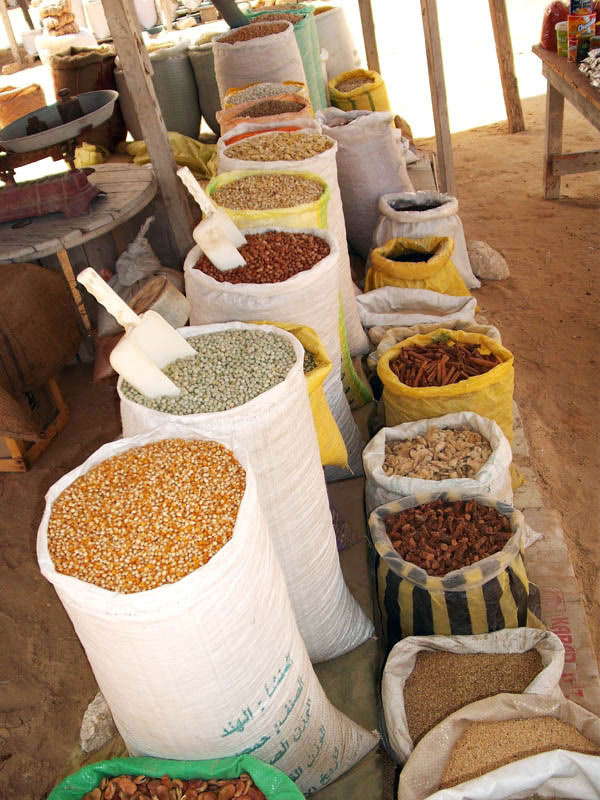
Sacks of dries beans, nuts, seeds and roots in a local market. Dried beans and grains are also a fundamental part of food in Libya. Chickpeas are soaked in water for a few hours, then cooked with tomato and meat sauce for couscous or added to pasta sauce. Broad beans are cooked in a dipping sauce of tomatoes and herbs and deliciously eaten with bread.
Mb'atten |
| |
 |
|
Mb'atten is really a Libyan specialty dish, prepared on special occasions, celebrations and festivities, often with Kofta and couscous. It is a unique dish never to be found anywhere else in the world (according to our current knowledge). It is made of slicing potato lengthwise into thin slices (about 3mm thick) but keeping each two slices joined together at the base, to form a sandwich, which will be stuffed with minced meat and herbs and then fried. The remaining mix of meat and herbs can be flattened into small burgers, dipped into white flour and then fried to make Kofta.
The Stuffing: a good quantity of minced meat (beef or lamb), about half of the mixture should be meat, a bundle of fresh green dill, a bundle of fresh parsley, two bundles of spring onion, a bit of fresh parsley, 3 cloves of garlic (ground into paste), teaspoon of salt, teaspoon of hot chili, 2 teaspoon of turmeric, a touch of cinnamon, 3 tablespoons of tomato puree, and one egg. (Modern variants of the dish do not include dill any more in the ingredients.) 
Weighing fresh herbs at the local market. The most common herbs used in some dishes, like Mb'atten, include spring onions, coriander, parsley, dill, and vine leaves (used for stuffing with rice). 
Cutting the fresh herbs, to be mixed with mince, egg, tomato puree, spices, salt. 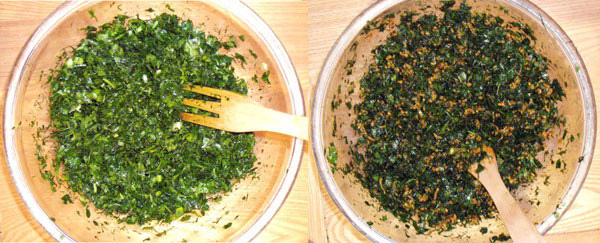
Finely chopped herbs (left), then mixed with mince meat, spices and the rest of the mix (right).

How to cut the pototo as described: you cut a thick slice, then cut each slice half way down. The second stage involves preparing the potatoes: slice the potato lengthwise, cutting one slice three-quarters down and stopping just before reaching the bottom, then cutting the second all the way down, ending with two slices of potatoes joined at the base, each about 3mm thick. Sprinkle some salt on all the slices and dry with kitchen paper, if wet. Open the two slices and stuff with the mixture (about 2 tablespoonfuls for each sandwich), until the sand witch is full and fat, and then tap in firmly with your hand along the exposed edge. 
Stuffing the potatoes with the mixture of mince and herbs. 
The herbs, the sliced potatoes, the egg mix and the flour. Stuff the slice, dipped in egg then in flour and put on the side (or straight into hot sizzling oil). 
Hold the two slices from the joined end and dip the exposed stuffing into white flour and then dip (only the exposed stuffing, not the rest of the potato) in egg (to hold together while frying) and throw in a deep fryer (or frying pan with lots of oil), and fry until golden brown.

These are now ready to eat, but traditionally, they can be cooked for a further few minutes in a saucepan with a bit of tomato sauce, as follows: place all the remaining potato pieces that were left over from the slicing in the saucepan, place all the stuffed potatoes on top, pour in a bit of tomato sauce, cover the saucepan, and heat over a very low heat for about ten minutes. This turns the fried potatoes into soft and sauce-covered delicious chunks, just like adding a bit of ketchup to chips. Serve warm with couscous or salad. If there is a lot of mixture left over, then roll into small balls, flatten onto a plate containing white flour, then fry in olive oil as koftas. The stuffed potatoes are also great cold, after being kept in the fridge overnight (my favourite).
 |
Summer Salad |
Traditional Libyan "slatha" is a main meal eaten by itself and is not a side dish that accompanies a main course. This is a traditional summer salad in Libya, often prepared by the beach for an easy and light lunch after swimming in the sea. Preparation: cut one onion very thinly into a large bowel, chop five tomatoes into six segments each, cut half cucumber into small cubes, throw in a handful of pitted green olives, cut one fresh green chili pepper into small pieces, add a pinch of salt, 3 tablespoons of olive oil, and about half a cup of water. Mix well by hand, squeezing the tomatoes and the vegetable to release some of the flavour into the water (but not to much as to mush up the contents), squeeze a bit of lemon and serve with crispy bread. 
Libyan Summer Salad The dish is eaten by breaking a piece of bread and dipping it into the salad and lifting some of the vegetables with it by folding it over the vegetables. Many of the younger generations nowadays add a tin of tuna to the salad for richer flavour and some protein.

Pumpkins at sale in the local market. Pumpkins are cooked in tomato and herb sauce with other vegetables like potatoes and carrots (or/and meat or chicken), and served either with couscous, rice or pasta, or even eaten as a dip with bread.
 |
Shorba (Libyan Soup): |
Fry finely-cut large onion and garlic in ghee until golden brown; add the meat cubes (beef or lamb), spices (turmeric, chili, salt, a bit of curry powder, and a teaspoonful of sugar), tomato puree and water, then cover and simmer for about 40 minutes until the meat is cooked. Add in the orzo (pasta shaped like pearls of barley) and cooked chickpeas and cook for 15 minutes until orzo is cooked. Chop a bit of fresh parsley and crush one clove of garlic and mix with olive oil and add to the mixture just before removing from the ring. Serve with lemon wedges, raw chopped parsley (sprinkled at the top) and crispy warm bread. |
|
|
|
| T'ajeen or Tajeen |
Peel and cut potatoes into thick slices, boil until cooked, crush, and spread in a "tajeen" (a baking tray). Fry thinly-chopped two onions until brown, and add the mince and cook for a few minutes, then add the crushed garlic and spice up with chili, turmeric, salt and curry powder, and stir and simmer until cooked. Remove and spread on a large plate and leave to cool. All the ingredients cold, add to the potatoes and mix in the beaten eggs and bake for 20 minutes at mark 180. Finally, take out from the oven, sprinkle some mozzarella cheese on top and bake for a further 15 minutes until the dish is covered with a light golden crust. Serve hot with crispy bread.
|
Boureek: Bureek: Burik: |
The Libyan basic boureek, also written as bourik, burik or bourek, is a very simple and deliciously crispy dish, made as follows:
- break an egg on a flat piece of pastry
- fold the other half of the pastry over to form a triangular shape
- pinch the edges together to seal firmly
- brush the edges with a solution of egg and water (to prevent the egg leaking out while frying)
- throw in hot oil to sizzle for a few minutes
- turn over and fry the other side for a few more minutes
- then take out and serve hot and crispy
Of course, there are other flavours of the dish, made by varying the filling, including one with minced meat: fry the meat with onions, add the herbs of your choice, then take a large table spoonful and spread on the pastry, break the egg on top, fold over and then continue as above. In other North African countries, like Algeria, the shape of the boureek is like a "spring roll" or a sausage roll.
Libyan Boureek
 |
Lebrak |
Lebrak is a dish made of stuffed vine leaves (locally called esselk leaves). In fact any kind of green thick leaves will probably do the job. The mixture is made of rice, tomato pure, herbs, spices, garlic, a bit of salt, and either small pieces of meat or mince. Mix all well, put a bit on a leaf, roll over and fold the edges, then place in a saucepan, making sure you place a few leaves in the bottom of the saucepan to take the heat, and these extra leaves (or carpet) often come out burnt. Once all in the saucepan, you need a lid that is slightly smaller than the saucepan so that it will drop all the way down inside the saucepan and sit directly on the stuffed pieces. Then you need a heavy stone to put on the lid, to keep it down. All this is to prevent the stuffed pieces from opening up while cooking. Finally put a little bit of water in the saucepan, not much at all (maybe a small cup), and then place over slow fire to simmer gently for about half an hour until the rice is cooked. Take out gently, sprinkle some olive oil, and serve. Really nice cold too.

 |
Mbekbka: Boiled-Macaroni |
Mbekbka: quick macaroni: Mbekbka is an onomatopoeic word derived from the sound of macaroni boiling in a saucepan. Instead of the European way of boiling pasta or spaghetti in water and then throwing the water away (with all the goodness it contains), the Libyans boil pasta with the sauce, which adds a real pasta flavour to the sauce. You can make it with any type of pasta, and the simplest dish involves frying onions in oil, throwing in the tomato puree, chili powder, turmeric, then adding water and salt and leave to boil, before adding the pasta. But the proper way to do it is to add some lamb chops, chickpeas and garlic to the sauce. Serve hot with a sprinkle of extra virgin olive oil, and lemon, fresh chili and crusty bread (optional) on a separate plate. You can also add other vegetable like pumpkin (as in photo), potato and green pepper.
 |
Megetta' (home-made fresh thick spaghetti): |
This dish is also probably very ancient. A fresh dough is knead from flour, and then flattened like thick pastry, (mixing with flour as you go to prevent it sticking together), cut into small strips as in photo, then cooked in tomato sauce with vegetables and/or meat. You need to cook the vegetables and meat in the sauce first, and only once these are nearly cooked, you add the pasta and cook for a few minutes more. 
Although it looks like spaghetti, it tastes much better, because you can taste the flavour of fresh pasta and because it is very chewy and delicious. Owing to the time it takes to prepare, don't expect your mum to cook this yummy dish for you as often as she would dry spaghetti.
 |
Rice |
Rice in Libya can be cooked either boiled with sauce, just like risotto, or steamed over a vegetable and meat sauce, just like couscous. The following one is steamed rice with meat, chickpeas and potato sauce. 
 |
O's'b'an or Ma'danous |
A kind of sausages stuffed with meat, liver, fresh herbs, onions and rice.Ma'danous is in a way a thicker kind of herb sausage, made of stuffing intestines with a mixture of fresh herbs, rice and meat and liver pieces. Preparing the intestines: clean the intestines with hot water, turning inside out and flashing all the way through, then marinate in a mixture of lemon juice and salt for at least one hour. Wash again, very well, and then stuff with the mix. The mixture: take two bundles of spring onion, two bundles of fresh parsley, a bit of mint, and one bundle of fresh coriander, chop finely in a large deep bowel, add the spices (chili, turmeric, salt, curry powder, black pepper, a handful of raw white rice, few spoonful's of olive oil, and then cut in the meat pieces of liver, kidney, lungs, heart and belly, which would have come with the intestines from the same animal. [This indicates that this dish was originated as a means of using up all the parts of the animal, as to avoid wasting nothing. Even the head and the legs are burnt on wood fire to remove all the hair, and then cleaned, chopped, and boiled in tomato and spice sauce to prepare a special stew.] Mix the mixture very well, then use to stuff the intestines, tie a couple of knots at each end, and place in a saucepan in which a sauce of tomatoes, spices and salt brought to boil. Remember one thing: before you put the stuffed intestines in the saucepan, make sure you prick them with a needle in few places, otherwise they will explode when the stuffing expands with heat. This dish may not appeal to some, but its unique flavour and rich aroma makes it more delicious than ordinary sausages.
 |
Ghrayba With Almonds |
Heat the butter, add the sugar, flour, almond, mix well, cut in diamonds, place in a baking tray, and put in a preheated oven. Once cooked (when it looks firm and slightly golden by the edges), remove from the oven and sprinkle some sugar over the ghrayba.
 |
Leka'ek or Ka'ek: |
Leka'ek is a kind of shortbread, made of flour, baking powder, and olive oil. Once the dough is knead, one takes a small piece, rolls it into a long round strips (just like sausage), then cuts it into short lengths, and rolls each one into a ring. You can leave this ring as it is, or take a knife and cut small cuts on the outer edge of the ring to give it the shape you see on the left. There are two verities, one with sugar added to the mixture to make sweet, and the other is salty, which makes it more like bread sticks. 
The one on the left is the sweet one, while the other is the salty leka'ek.
 |
Watermelons & Melons: |
watermelon market, with the scales just by the edge of the road. In the way back from work one often pulls over, choose a good melon, weighs it, pays for it, puts it in the car, then continues the journey home.

|
Bsisa: Ademmin: |
Excellent ancient breakfast. Bsisa or Ademmin, topped with halva. Bsisa is probably very ancient.
A sweet, rich-textured dish with strong aroma of ground coriander seeds and olive oil, best eaten with palm dates, and washed down with hot black tea. Nothing like it. Recipe: - Dry barley
- Dry chickpeas
- Dry green lentils
- Dry broad beans
- Fenugreek seeds
- Coriander seeds (and/or sweet cumin seeds)
- Turmeric
- Sugar
- Oil
Mostly made of ground roasted chickpeas, and handfuls of roasted green lentils, barely, and broad beans, a bit of turmeric (good for the stomach), a few coriander seeds, all ground and sieved into fine powder, finally mixed with sugar and kept in a sealed jar. The powder can last for the whole year (or even longer). Whenever you want some bsisa, you would take a bit of powder into a bowel and mix with extra virgin olive oil until smooth and ready to eat. The yellow colour comes from the colour of ground chickpeas and of turmeric. Some recipes of bsisa include sweet cumin seeds. Chickpeas are very rich in iron and therefore important to vegetarians. The fenugreek seeds are very, very bitter, and their taste succulently stays in the mouth as an after taste to the sweet bsisa, similar to the zest of a sweet orange that lingers behind on the tongue. You can eat it in its own, two or three table spoonfuls at a time, not more; but traditionally bsisa is served with palm dates (either fresh, or slightly fried in olive oil and fenugreek powder) and a glass of milk or, my favourite, a cup of hot black tea. Recently, the new generations modify the original recipe by adding almonds, honey, or halva (as in the photo above), which is a similar sweet of its own, made of crushed sesame seeds, flour, sugar and oil.
|
Magrood |
Filling: mix one pound of dates (paste) with one teaspoon of cinnamon and three tablespoons of olive oil. Take a handful of the mixture and shape into a small ball, roll into a long thick strip. Dough: mix about 4 cups of semolina, one teaspoon of baking powder, half a cup of flour and one cup of oil. Mix into soft dough and roll into a shape of a loaf. Press a deep line along the middle of the loaf, and stuff with the date mixture and roll again into a closed loaf (this keeps the date mixture inside the dough), then cut into diagonal, 2 inch pieces (like diamonds), and place in a baking tray. Bake in a preheated oven at mark 200) for about 35 minutes, or until golden brown. Take out of the oven, and while still hot pour the sugar syrup and/or honey over the whole pieces, and leave to soak for a while, before serving.
 |
Seafood: Fish & Squid & Octopus |
Libyan diet is also rich in sea food, like fresh fish, and sun-dried octopus and squids. Couscous with dried octopus is an old delicacy the new generations seem to gradually leave behind; probably due to the fact that this dish requires a long time to prepare. First, the octopus needs to be dried in the sun for days, then cut and preserved, then boiled in water for hours, before finally adding it to the tomato and herb stew. Once tender and flavoured with garlic and olive oil, couscous with octopus stew is really something special. The main types of fish used include the following: 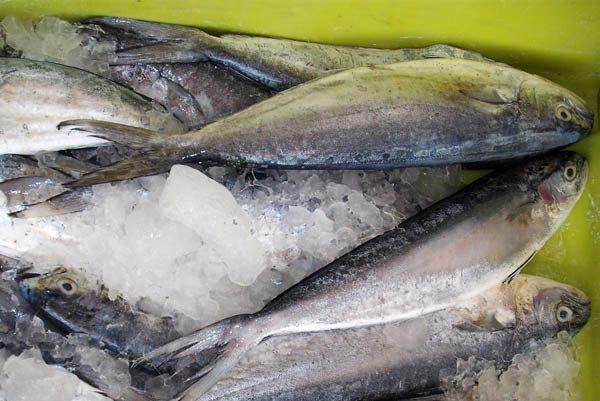
Ambuka (Lambuket) 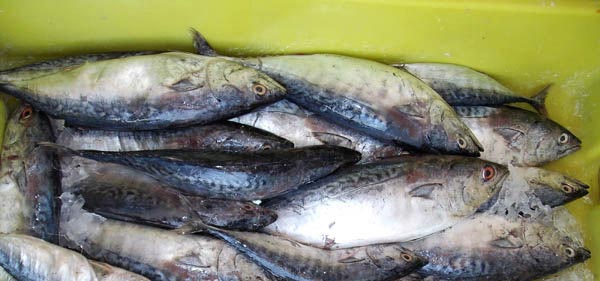
Azdouz 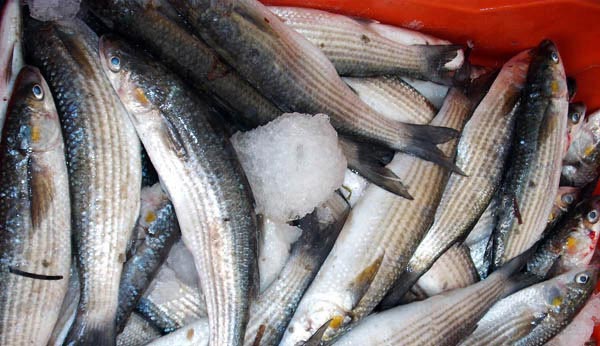
Awragh 
Azday |
|
|
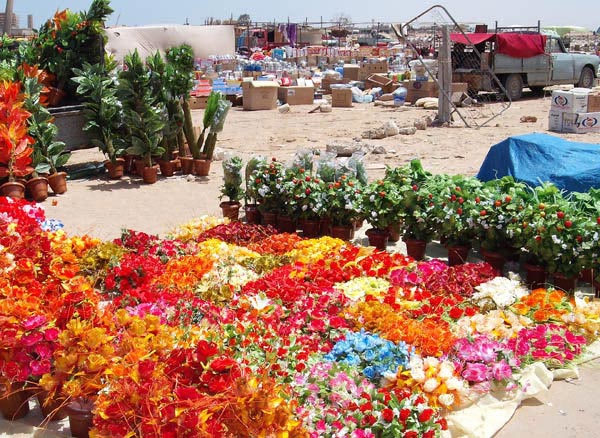
Flower and plant market. The Peugeot 404 is very characteristic of Libya.
|
|
 |
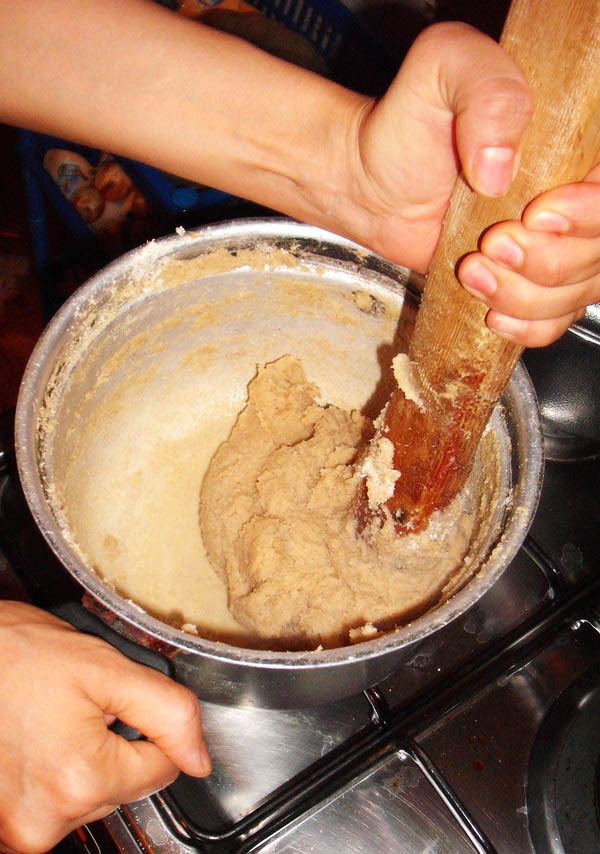
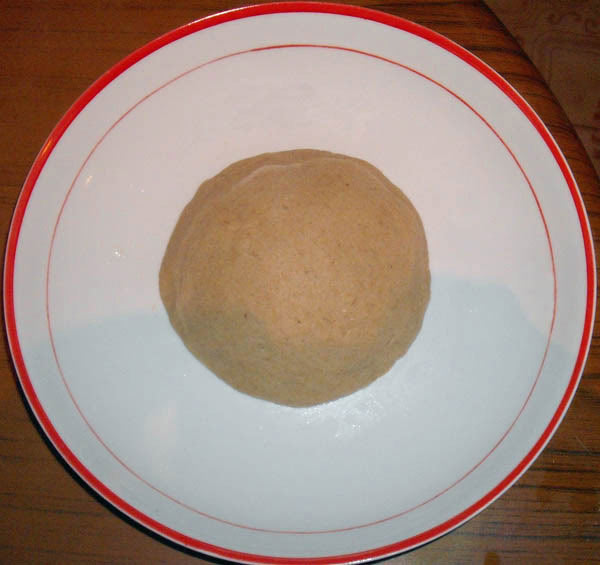
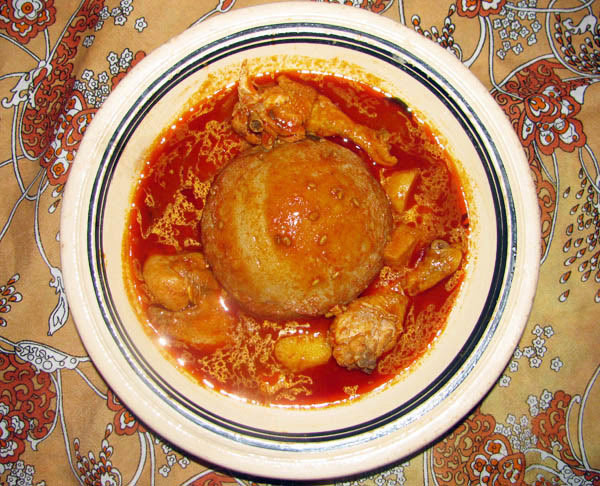
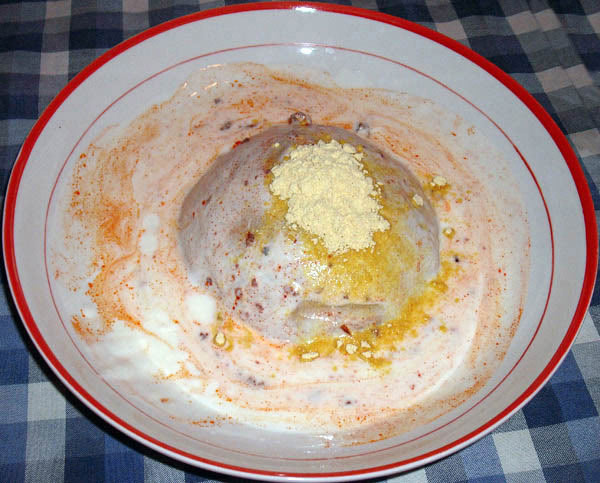
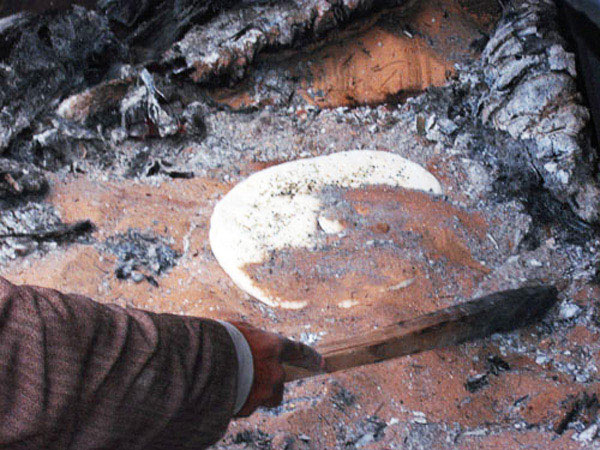
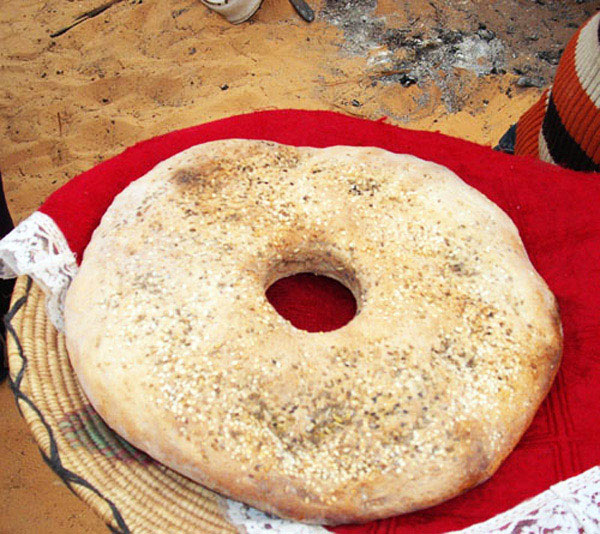
























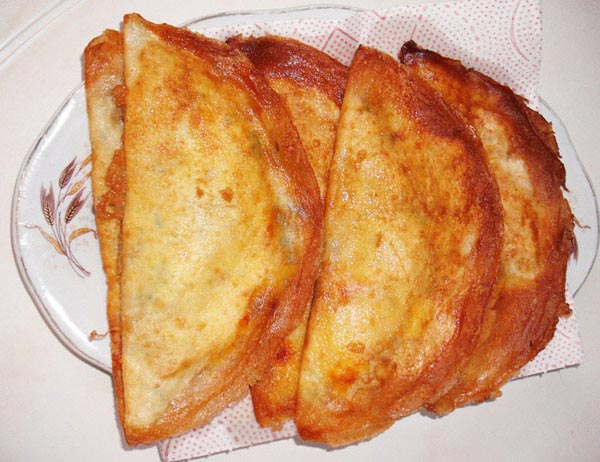






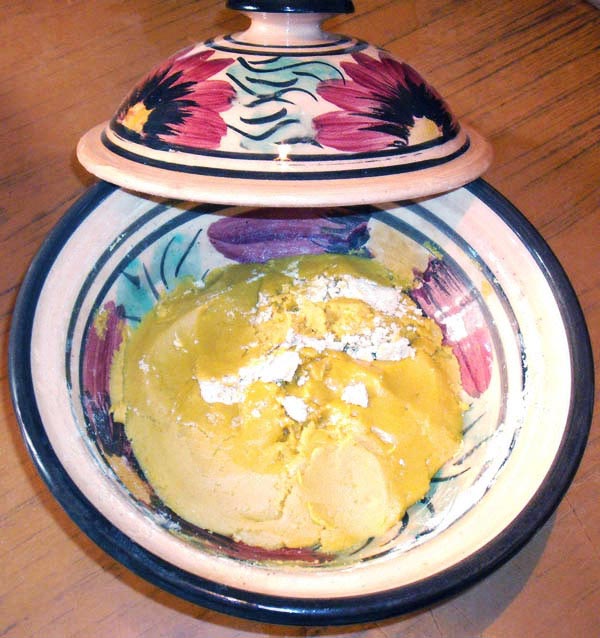







No comments:
Post a Comment